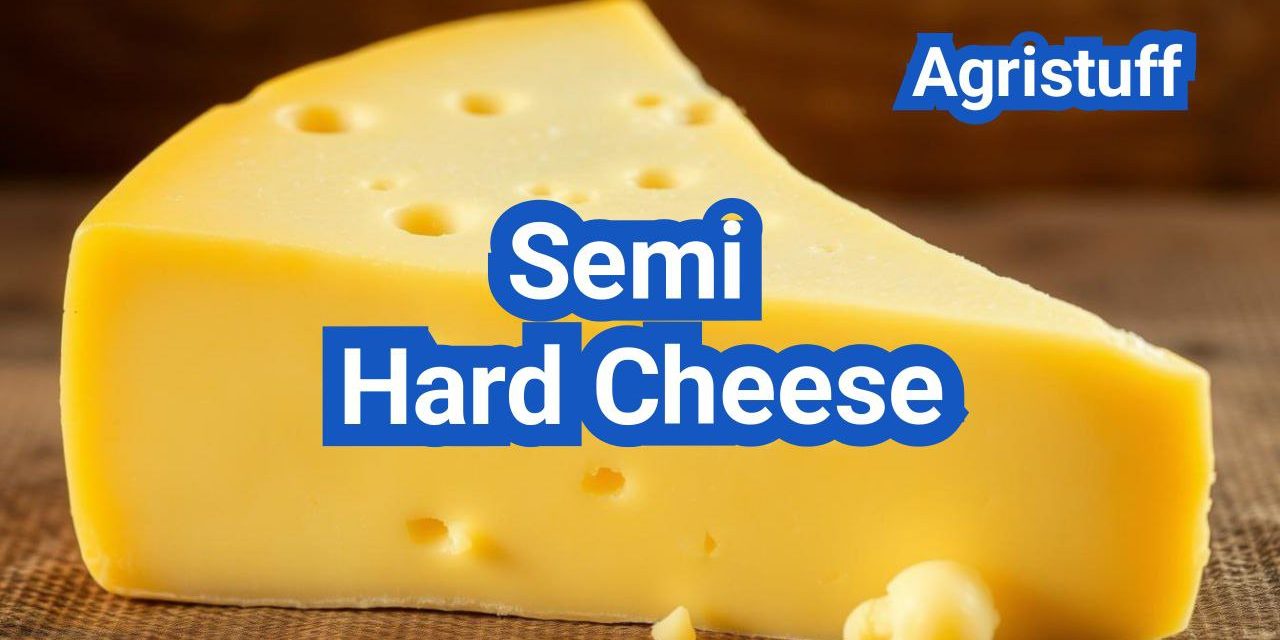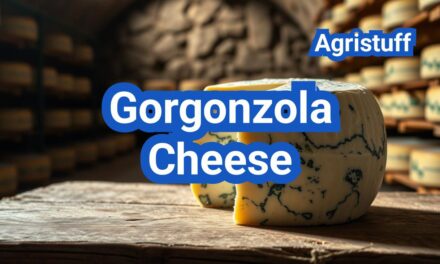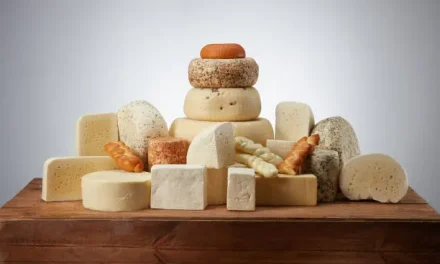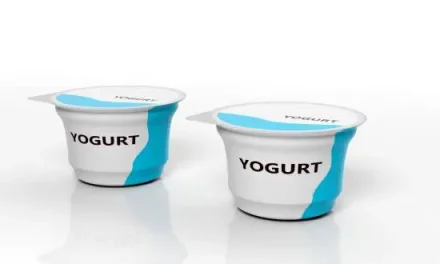Semi-hard cheese is a category of cheese that has gained popularity worldwide for its rich flavors and versatile textures. It includes favorites like Queso Manchego, Gouda, Havarti, and Gruyère.
This type of cheese is characterized by its firm yet slightly springy texture, achieved through a careful balance of moisture and aridity. The flavors range from savory to tangy, making semi-hard cheese a delightful addition to various culinary dishes.
The process of making semi-hard cheese involves a blend of traditional techniques and precise control over aging and moisture levels, resulting in a diverse array of types and flavors.
Key Takeaways
- Definition and characteristics of semi-hard cheese
- Popular types of semi-hard cheese, such as Gouda and Edam
- The making process and its impact on flavor and texture
- Versatility in culinary uses
- Examples of semi-hard cheese and their unique qualities
What Is Semi-Hard Cheese?
Understanding semi-hard cheese requires a look into its definition, characteristics, and how it fits into the broader cheese spectrum. Semi-hard cheeses are known for their balanced properties, sitting between soft and hard cheeses in terms of moisture content and texture.
Definition and Classification
Semi-hard cheese is defined by its moderate moisture content, which is higher than that of hard cheeses but lower than soft cheeses. This characteristic gives semi-hard cheese its unique properties, making it versatile for various culinary applications. The classification of semi-hard cheese is based on its texture, aging process, and production methods.
The aging process for semi-hard cheese can vary, resulting in a range of flavors from mild and creamy to sharp and nutty. The production methods, including the type of milk used (cow, goat, or sheep), also play a significant role in defining the characteristics of semi-hard cheese.
Where Semi-Hard Cheese Fits in the Cheese Spectrum
Semi-hard cheese occupies a middle ground in the cheese spectrum, between soft cheeses like brie and feta, and hard cheeses like parmesan and cheddar. This positioning is due to its moisture content and aging process, which influence its texture and flavor profile.
| Cheese Type | Moisture Content | Aging Process | Texture |
|---|---|---|---|
| Soft Cheese | High | Short to None | Creamy, Soft |
| Semi-Hard Cheese | Moderate | Variable | Flexible, Smooth |
| Hard Cheese | Low | Long | Crumbly, Hard |
The table above illustrates the differences between soft, semi-hard, and hard cheeses, highlighting the unique characteristics of semi-hard cheese. Its moderate moisture content and variable aging process make it a versatile option for cooking and pairing.
Key Characteristics of Semi Hard Cheese

Semi-hard cheese stands out due to its balanced moisture content and rich, nuanced flavors. This category of cheese is defined by several key characteristics that set it apart from other types of cheese.
Moisture Content and Texture
The moisture content of semi-hard cheese plays a crucial role in determining its texture. Typically, semi-hard cheeses have a moisture content that allows them to be firm yet slightly springy. This texture makes them versatile for various culinary applications.
Texture Characteristics:
- Firm but yielding to pressure
- Smooth or slightly granular texture
- Can be sliced thinly for sandwiches or platters
pH Levels and Aging Potential
The pH level of semi-hard cheese influences its aging potential. Cheeses with a lower pH tend to age more gracefully, developing complex flavors over time. The aging process can range from a few months to several years, depending on the type of cheese.
| pH Level | Aging Potential | Flavor Profile |
|---|---|---|
| 4.5 – 5.5 | 3 – 6 months | Mild, creamy |
| 5.0 – 6.0 | 6 – 12 months | Rich, slightly sharp |
| 5.5 – 6.5 | 1 – 2 years | Sharp, nutty |
Flavor Profiles and Aromas
Semi-hard cheeses are renowned for their diverse flavor profiles and aromas. The flavor can range from mild and buttery to sharp and nutty, depending on the aging process and type of milk used.
Common Flavor Profiles:
- Buttery and caramel notes
- Nutty and slightly sweet
- Fruity and tangy
Understanding these characteristics is essential for appreciating the unique qualities of semi-hard cheese and exploring its various culinary uses.
The Science Behind Semi-Hard Cheese
The production of semi-hard cheese involves a complex interplay of milk composition, bacterial cultures, and enzymatic activities. Understanding these elements is crucial to appreciating the unique characteristics of semi-hard cheese.
Milk Composition and Its Impact
The composition of milk, including its fat content and protein structure, plays a significant role in determining the characteristics of semi-hard cheese. Milk fat content affects the cheese’s flavor and texture, while the protein structure influences its melting properties and overall texture.
Bacterial Cultures and Their Role
Bacterial cultures are essential in the production of semi-hard cheese, as they convert the milk sugar (lactose) into lactic acid. This process not only lowers the pH of the milk but also contributes to the development of the cheese’s flavor and texture. Different types of bacterial cultures can be used to create various flavor profiles.
Enzymatic Activities During Aging
During the aging process, enzymatic activities break down the fats and proteins in the cheese, leading to the development of its characteristic flavor and texture. The aging process can vary in length and conditions, affecting the final product’s quality and characteristics.
In conclusion, the science behind semi-hard cheese is a multifaceted process involving milk composition, bacterial cultures, and enzymatic activities during aging. Understanding these elements can enhance appreciation for the craftsmanship involved in producing high-quality semi-hard cheese.
How Semi-Hard Cheese Is Made: Step-by-Step Process

Semi-hard cheese production is a complex process that transforms milk into a delicious, versatile product. This process involves several key steps, from milk selection to the final molding and pressing of the cheese.
Milk Selection and Preparation
The journey to creating semi-hard cheese begins with the selection of high-quality milk. The milk used can come from cows, goats, or sheep, each imparting unique characteristics to the cheese. The milk is then prepared by adjusting its fat content and pasteurizing it to eliminate harmful bacteria.
Milk Composition: The composition of the milk, including its fat content, protein levels, and bacterial cultures, plays a crucial role in determining the final characteristics of the cheese.
| Milk Type | Fat Content | Protein Level |
|---|---|---|
| Cow’s Milk | 3.5% | 3.2% |
| Goat’s Milk | 3.8% | 3.5% |
| Sheep’s Milk | 6.0% | 5.5% |
Curdling and Cutting Techniques
The next step involves curdling the milk using rennet, a complex of enzymes that helps to coagulate the milk. The curd is then cut into small pieces to release whey and create a smooth, even texture.
Curdling Process: The curdling process is critical as it determines the final texture of the cheese. The size of the curd particles and the cutting technique can significantly affect the cheese’s characteristics.
Cheddaring and Washed Curd Methods
After cutting, the curds may undergo cheddaring or washed curd processes. Cheddaring involves stacking and turning the curds to expel whey, while washed curd involves rinsing the curds with water to remove excess lactose and create a milder flavor.
Cheddaring: This process involves cutting the curd into blocks, stacking them, and turning them to release more whey. It’s a traditional method used for cheeses like Cheddar.
Molding and Pressing
The final step involves molding the curds into their desired shape and pressing them to remove any remaining whey. The pressure applied during this stage can vary, affecting the cheese’s final texture and density.
Molding Techniques: The molding process is crucial for giving the cheese its final form. Different molds can be used to create various shapes and sizes.
The Art of Affinage: Aging Semi-Hard Cheese
The art of affinage involves carefully aging semi-hard cheese under optimal conditions to enhance its flavor and texture. This process is crucial in developing the characteristic taste and consistency that define semi-hard cheeses.
Optimal Conditions for Aging
Aging semi-hard cheese requires precise control over temperature, humidity, and air quality. Optimal aging conditions can vary depending on the type of cheese, but generally, a cool, humid environment is preferred.
The ideal temperature for aging semi-hard cheese typically ranges between 35°F to 55°F (2°C to 13°C), with humidity levels between 80% to 90%. Maintaining these conditions is essential for flavor development and preventing unwanted mold or bacterial growth.
| Cheese Type | Ideal Temperature (°F) | Ideal Humidity (%) | Aging Duration |
|---|---|---|---|
| Gouda | 45-50 | 80-85 | 3-6 months |
| Cheddar | 50-55 | 85-90 | 6-12 months |
| Manchego | 40-45 | 80-85 | 3-9 months |
How Aging Affects Flavor and Texture
Aging significantly impacts both the flavor and texture of semi-hard cheese. As cheese ages, enzymes break down fats and proteins, leading to the development of complex flavors and a smoother texture.
The longer a semi-hard cheese is aged, the more pronounced its flavor becomes. For example, a young Gouda may have a mild, creamy taste, while an aged Gouda develops a nutty, caramel flavor.
Traditional vs. Modern Aging Techniques
Traditional aging techniques involve natural aging processes, where cheeses are aged in environments like caves or cellars. Modern techniques, however, may utilize controlled aging rooms with precise temperature and humidity control.
While traditional methods offer a rich, nuanced flavor profile, modern techniques provide consistency and predictability in the aging process.
Popular Types of Semi-Hard Cheese
From European classics to American innovations, semi-hard cheese types are as diverse as they are delicious. This diversity is a result of centuries-old traditions, regional preferences, and innovative cheese-making techniques.
European Classics
European countries have a rich history of producing exceptional semi-hard cheeses. Gouda, originating from the Netherlands, is known for its smooth, creamy texture and nutty flavor. Gruyère from Switzerland is another classic, celebrated for its rich, slightly sweet taste and excellent melting properties.
Other notable European semi-hard cheeses include Manchego from Spain, known for its firm texture and slightly sweet, nutty flavor, and Comté from France, appreciated for its complex, fruity flavors.
American Semi-Hard Cheeses
The United States has its own thriving tradition of semi-hard cheese production. Monterey Jack is a popular variety, known for its mild flavor and excellent melting properties, making it a favorite for cooking and snacking.
Colby is another American semi-hard cheese, similar to Cheddar but with a milder flavor and a moister texture. These cheeses have become staples in American cuisine, often used in dishes ranging from burgers to macaroni and cheese.
British Semi-Hard Cheese Traditions
The UK is renowned for its rich cheese-making heritage, with Cheddar being one of the most famous semi-hard cheeses globally. Originating from Somerset, England, Cheddar is known for its rich, tangy flavor and firm texture.
Double Gloucester is another traditional British semi-hard cheese, characterized by its rich, buttery flavor and smooth texture. These cheeses are often enjoyed on their own or paired with fruits and crackers.
Comprehensive List of Semi-Hard Cheeses

The category of semi-hard cheeses encompasses a broad range of products made from cow’s, goat’s, and sheep’s milk, as well as mixed milk varieties. This diversity allows for a wide array of flavors and textures, catering to various consumer preferences.
Cow’s Milk Semi-Hard Cheeses
Cow’s milk is the most commonly used milk type in semi-hard cheese production, offering a mild flavor profile and versatile usage in culinary applications.
| Cheese Name | Origin | Description |
|---|---|---|
| Gouda | Netherlands | Mild, creamy, and smooth |
| Edam | Netherlands | Mild, slightly salty |
| Manchego | Spain | Nutty, slightly sweet |
Goat and Sheep’s Milk Varieties
Goat and sheep’s milk semi-hard cheeses are known for their distinct flavors, often described as tangy and rich. These cheeses are produced in various regions and are appreciated for their unique characteristics.
| Cheese Name | Milk Type | Origin |
|---|---|---|
| Crottin de Chavignol | Goat’s | France |
| Idiazabal | Sheep’s | Spain |
| Majorero | Goat’s | Canary Islands |
Mixed Milk Semi-Hard Cheeses
Mixed milk semi-hard cheeses combine the characteristics of different milk types, resulting in complex and intriguing flavors. These cheeses are a testament to the versatility of dairy production.
| Cheese Name | Milk Types | Description |
|---|---|---|
| Mixed Milk Gouda | Cow’s & Goat’s | Rich, creamy |
| Beaufort | Cow’s & Sheep’s | Nutty, slightly sweet |
Detailed Examples of Notable Semi-Hard Cheeses

The world of semi-hard cheese is vast and varied, encompassing a broad spectrum of tastes and production techniques. This diversity is reflected in the numerous types of semi-hard cheeses produced globally, each with its unique characteristics and cultural significance.
Cheddar: The Familiar Classic
Cheddar is one of the most recognized semi-hard cheeses worldwide, originating from the English village of Cheddar. Its popularity stems from its rich, tangy flavor and smooth texture, making it a staple in many cuisines. Cheddar is produced using cow’s milk and undergoes a process of cheddaring, which involves stacking and turning the curds to expel excess whey.
Characteristics: Rich, tangy flavor; smooth texture; aged for varying periods.
Gouda: Dutch Excellence
Gouda, named after the Dutch city of Gouda, is a semi-hard cheese known for its mild, creamy flavor when young and sharp, nutty taste when aged. The aging process significantly affects its taste and texture, with younger Gouda being milder and softer.
Aging Process: Gouda can be aged for different durations, resulting in a range of flavors from mild to sharp.
Gruyère and Emmental: Swiss Perfection
Gruyère and Emmental are two iconic Swiss cheeses. Gruyère is known for its rich, creamy flavor with a hint of nuttiness, while Emmental is famous for its large holes and mild, slightly sweet taste. Both are used extensively in Swiss cuisine, particularly in fondue and gratins.
| Cheese | Flavor Profile | Texture |
|---|---|---|
| Gruyère | Rich, creamy, nutty | Smooth, slightly firm |
| Emmental | Mild, slightly sweet | Firm, with large holes |
Monterey Jack and Colby: American Innovation
Monterey Jack and Colby are semi-hard cheeses that originated in the United States. Monterey Jack is known for its mild flavor and excellent melting properties, making it a favorite for grilled cheese sandwiches and nachos. Colby, on the other hand, is milder than Cheddar and has a more open texture.
These notable semi-hard cheeses showcase the diversity and richness of cheese-making traditions around the world. Each type offers unique flavors and textures, catering to a wide range of culinary applications.
Artisanal vs. Commercial Semi-Hard Cheese Production

Semi-hard cheese production encompasses a range of methods, from traditional artisanal techniques to modern commercial manufacturing processes. The distinction between artisanal and commercial production lies not only in the scale of production but also in the techniques, ingredients, and philosophies behind the cheese-making process.
Traditional Craftsmanship
Artisanal semi-hard cheese production is characterized by traditional craftsmanship, where cheese makers adhere to time-honored techniques passed down through generations. These artisans often use raw milk, which is believed to contribute to a richer, more complex flavor profile. The process is typically labor-intensive, involving manual curdling, cutting, and shaping techniques.
The use of raw milk in artisanal production is a subject of debate. Proponents argue that it enhances the cheese’s flavor and nutritional profile, while critics point to potential health risks. Nonetheless, artisanal producers often pride themselves on their ability to craft unique cheeses that reflect their terroir and traditional methods.
Modern Manufacturing Techniques
Commercial semi-hard cheese production, on the other hand, relies on modern manufacturing techniques to produce cheese on a large scale. This involves pasteurization to ensure safety and consistency. Commercial producers often use mechanized processes to curdle, cut, and shape the cheese, significantly reducing labor and increasing efficiency.
While some argue that commercial production sacrifices flavor and character for the sake of consistency and shelf life, others see it as a necessary step to meet the demands of a global market. The use of pasteurized milk is standard in commercial production, providing a safer product with a longer shelf life.
Pasteurized vs. Raw Milk Debate
The debate between pasteurized and raw milk in cheese production is ongoing. Pasteurization involves heating the milk to kill harmful bacteria, enhancing safety but potentially affecting flavor. Raw milk, on the other hand, retains its natural bacteria and enzymes, which some believe contribute to a richer taste experience.
The choice between pasteurized and raw milk significantly impacts the final product. While raw milk cheeses are often praised for their complex flavors, pasteurized milk cheeses are valued for their safety and consistency. This dichotomy reflects the broader differences between artisanal and commercial cheese production.
Semi-Hard Cheese vs. Other Cheese Types

The diverse world of cheese includes semi-hard varieties that stand out from soft, hard, and semi-soft cheeses. Understanding these differences is crucial for appreciating the unique qualities of semi-hard cheese.
Comparison with Soft Cheeses
Soft cheeses, such as Brie and Camembert, are characterized by their creamy textures and mild flavors. In contrast, semi-hard cheeses have a firmer texture and a more pronounced flavor profile. For instance, Gouda, a semi-hard cheese, has a nutty flavor that develops with age, whereas soft cheeses tend to remain mild.
A key difference between soft and semi-hard cheeses lies in their production processes. Soft cheeses are often made with higher moisture content and less aging, resulting in a softer texture. Semi-hard cheeses, on the other hand, undergo a longer aging process, which contributes to their characteristic firmness and complex flavors.
Differences from Hard Cheeses
Hard cheeses, like Parmesan and Grana Padano, are known for their granular texture and sharp flavors. While semi-hard cheeses share some similarities with hard cheeses in terms of aging, they differ significantly in texture. Semi-hard cheeses are more pliable and easier to slice, making them ideal for various culinary applications.
“The art of cheese-making is a delicate balance between tradition and innovation, where the nuances of texture and flavor are carefully crafted.” –
Cheese Artisan
The aging process for hard cheeses is typically longer than for semi-hard cheeses, resulting in a more pronounced flavor. However, semi-hard cheeses still develop a rich flavor profile that is distinct from their hard counterparts.
| Cheese Type | Texture | Flavor Profile |
|---|---|---|
| Semi-Hard | Firm, yet pliable | Nutty, rich |
| Soft | Creamy | Mild |
| Hard | Granular | Sharp, pronounced |
Semi-Hard vs. Semi-Soft: Understanding the Distinction
The distinction between semi-hard and semi-soft cheeses can be subtle, as both categories fall between soft and hard cheeses in terms of texture. However, semi-hard cheeses tend to be more dense and less moist than semi-soft cheeses. For example, Havarti, a semi-soft cheese, has a buttery flavor and a smooth texture, whereas a semi-hard cheese like Manchego is nuttier and firmer.
- Semi-hard cheeses are generally aged longer, developing a more complex flavor.
- Semi-soft cheeses have a higher moisture content, making them more suitable for spreading.
In conclusion, semi-hard cheese occupies a unique niche in the world of cheese, distinct from soft, hard, and semi-soft varieties. Its characteristic texture and flavor profile make it a versatile ingredient in various culinary contexts.
Culinary Uses of Semi-Hard Cheese

Semi-hard cheese is a versatile ingredient in many culinary applications. Its balanced texture and rich flavor profile make it suitable for a variety of dishes, from comfort food to gourmet cuisine.
Melting Properties and Cooking Applications
Semi-hard cheeses are known for their excellent melting properties, making them ideal for dishes that require a smooth, creamy texture. Gouda and Cheddar are popular choices for macaroni and cheese, grilled cheese sandwiches, and cheese sauces. The melting point of semi-hard cheese is generally lower than that of hard cheeses, but higher than soft cheeses, allowing for a wide range of cooking applications.
Some common cooking applications include:
- Melting over vegetables or meats
- Adding depth to soups and stews
- Creating creamy pasta dishes
- Enhancing the flavor of casseroles
Pairing with Foods and Beverages | Semi Hard Cheese
Semi-hard cheese can be paired with a variety of foods and beverages to enhance its flavor. Fruits, nuts, and crackers are common accompaniments. For beverages, wine, beer, and cider are popular choices. The key is to balance the flavors so that neither the cheese nor the accompaniment overpowers the other.
| Cheese Type | Recommended Pairing |
|---|---|
| Gouda | Fig jam, apple slices |
| Cheddar | Chutney, ale |
| Manchego | Membrillo, olives |
Recipe Ideas Featuring Semi-Hard Cheese
Semi-hard cheese can be the star of many recipes. Here are a few ideas to get you started:
- Gouda and Fig Jam Grilled Cheese: A gourmet twist on the classic grilled cheese, featuring Gouda cheese and fig jam.
- Cheddar and Broccoli Soup: A creamy soup that combines the richness of cheddar with the nutritional benefits of broccoli.
- Manchego and Quince Tart: A sweet and savory tart that pairs Manchego cheese with quince paste.
Creating the Perfect Semi-Hard Cheese Board

The perfect semi-hard cheese board is a symphony of flavors and textures, carefully curated to delight the palate. It’s not just about throwing a few cheeses together; it’s an art that requires thought and planning.
Selection and Variety | Semi Hard Cheese
When it comes to selecting semi-hard cheeses for your board, variety is key. You want to include a range of flavors and textures to keep things interesting. Consider including:
- A young, mild cheese like Gouda or Manchego
- A more aged, sharp cheese like Cheddar or Gruyère
- A cheese with a distinct flavor profile, such as Smoked Gouda or Sap Sago
This selection will not only cater to different tastes but also provide a visually appealing board.
Accompaniments and Pairings | Semi Hard Cheese
No cheese board is complete without accompaniments and pairings. For semi-hard cheeses, consider:
- Fruits: Apples, grapes, and berries complement the richness of cheese
- Nuts: Almonds, walnuts, and pecans add crunch and depth
- Breads and crackers: Offer a variety, such as baguette slices, crackers, or crostini
- Spreads and jams: Fig jam, honey, and mustard can add interesting flavor dimensions
Pairing these items with your selected cheeses will enhance the overall experience. For example, a sharp cheddar pairs well with apple slices, while a mild Gouda goes nicely with fig jam.
Presentation Tips and Techniques | Semi Hard Cheese
The presentation of your cheese board can elevate the experience. Here are some tips:
- Arrange cheeses in a visually appealing pattern, varying the heights and textures
- Use small bowls or ramekins for spreads and jams
- Garnish with fresh herbs or edible flowers for a pop of color
- Label the cheeses so guests know what they’re enjoying
By following these guidelines, you’ll create a semi-hard cheese board that’s not only delicious but also a feast for the eyes.
Semi-Hard Cheese in Popular Culture

Beyond its culinary uses, semi-hard cheese has carved out a niche in popular culture, reflecting its significance in society. This type of cheese has managed to transcend its role as a mere food item to become a part of various cultural practices and events.
Semi-Hard Cheese in Crossword Puzzles
Semi-hard cheese often appears in crossword puzzles, with types like Gouda and Cheddar being popular answers. The frequent inclusion of these cheeses in puzzles highlights their familiarity and cultural relevance.
Regional Celebrations and Cheese Festivals | Semi Hard Cheese
Many regions celebrate their cheese-making heritage through festivals and events. For instance, the annual Wisconsin Cheese Festival in the United States and the Gouda Cheese Festival in the Netherlands attract visitors from around the world, showcasing the cultural significance of semi-hard cheese.
These events not only promote local cheese production but also foster a sense of community among cheese enthusiasts. They often feature cheese tastings, cheese-making demonstrations, and other activities that celebrate the rich tradition of semi-hard cheese production.
At The End of: Semi Hard Cheese
Semi-hard cheese is a diverse and complex category, encompassing a wide range of types, production methods, and culinary uses. This comprehensive overview has explored the characteristics, production processes, and various applications of semi-hard cheese, providing a deeper understanding of its significance in the world of cheese.
The semi-hard cheese category includes a broad spectrum of cheeses, from well-known types like Cheddar and Gouda to lesser-known varieties. Understanding the differences between these cheeses, including their moisture content, aging potential, and flavor profiles, can enhance appreciation for the craftsmanship involved in their production.
In conclusion, semi-hard cheese offers a rich culinary experience, with its versatility in cooking and pairing making it a staple in many cuisines. As a summary, this article has highlighted the key aspects of semi-hard cheese, providing insights into its production, characteristics, and uses, ultimately contributing to a greater appreciation of this cheese category.
FAQ
What is semi-hard cheese?
Semi-hard cheese is a type of cheese that falls between soft and hard cheeses in terms of texture and moisture content. It is characterized by a firm texture, but still yields to pressure.
What are the characteristics of semi-hard cheese?
Semi-hard cheese typically has a moisture content between 30-40%, a pH level between 5.0-5.5, and a texture that is smooth and even. The flavor profile can vary depending on the type of milk used and the aging process.
How is semi-hard cheese made?
Semi-hard cheese is made through a process that involves milk selection and preparation, curdling and cutting, cheddaring or washed curd methods, and molding and pressing. The specific techniques used can vary depending on the type of cheese being produced.
What are some popular types of semi-hard cheese?
Some popular types of semi-hard cheese include Cheddar, Gouda, Gruyère, Emmental, and Monterey Jack. These cheeses are known for their rich flavor profiles and versatility in cooking and pairing.
What is the difference between artisanal and commercial semi-hard cheese production?
Artisanal semi-hard cheese production involves traditional craftsmanship and often uses raw milk, while commercial production uses modern manufacturing techniques and pasteurized milk. The debate surrounding pasteurized vs. raw milk centers on the impact on flavor and food safety.
How do I store semi-hard cheese?
Semi-hard cheese should be stored in a cool, dry place, wrapped in a breathable material such as wax paper or cheese paper. This will help to maintain the cheese’s flavor and texture.
Can semi-hard cheese be melted?
Yes, semi-hard cheese can be melted and is often used in cooking applications such as grilled cheese, mac and cheese, and fondue.
What are some pairing suggestions for semi-hard cheese?
Semi-hard cheese can be paired with a variety of foods and beverages, including crackers, fruit, charcuterie, and wine. The specific pairing will depend on the type of cheese and personal preference.
How do I create a semi-hard cheese board?
To create a semi-hard cheese board, select a variety of cheeses, accompaniments such as crackers and fruit, and beverages such as wine or beer. Arrange the items in a visually appealing way and consider adding garnishes such as nuts or fresh herbs.
Conclusion of: Semi Hard Cheese
What does “semi hard cheese” mean?
In practice, semi hard cheese is a broad style name for pressed, sliceable cheeses with moderate moisture and firm, elastic texture; it’s widely used in industry and academia even though U.S. labeling laws define cheeses by variety rather than by a legal “semi-hard” category. In other words, American rules set moisture/fat limits for specific cheeses like Cheddar or Gouda, while international standards group cheeses by firmness (soft, semi-soft, semi-hard, hard) based on moisture on a fat-free basis. American Cheese Society explainer
How standards classify semi hard cheese
Globally, semi hard cheese aligns with firmness classes in the Codex General Standard for Cheese, which organizes cheeses by ripening and by moisture on a fat-free basis (MFFB)—the metric behind “soft, semi-soft, semi-hard, hard.” This helps buyers and makers compare textures across varieties even when national regulations differ. Codex CXS 283-1978
U.S. rules you should know about semi hard cheese
In the U.S., most semi hard cheese varieties are regulated under 21 CFR Part 133 (standards of identity): each named cheese has maximum moisture and minimum milkfat limits; if the milk isn’t pasteurized, it must be cured at ≥35 °F for at least 60 days—the well-known “60-day rule.” 21 CFR Part 133 (eCFR)
Moisture, fat, pH: the trio behind semi hard cheese texture
What makes a semi hard cheese feel firm yet supple is the balance of moisture, fat, and acidity: lower moisture and a pH in the ~5.2–5.6 range build a cohesive casein network that slices cleanly yet still melts; control of moisture begins with curd size, cooking, and pressing. UW–Madison CDR: Acidity & Moisture
Why many semi hard cheese styles melt beautifully
From grilled cheese to fondue, many semi hard cheese styles are “goldilocks” melters: enough bound calcium to hold shape, enough moisture to flow when heated. Cheesemakers steer melt via acidity at set/drain and calcium balance. CDR Dairy Pipeline (melt & stretch)
Science note for semi hard cheese fans
If you love semi hard cheese on burgers or in sauces, good melt comes from a “just right” level of protein–calcium bonds; too much calcium and it won’t melt, too little and it turns runny. Scientific American: Why some cheeses melt better
How semi hard cheese is made (big-picture steps)
Whether Cheddar, Gouda, or Jack, most semi hard cheese follow classic rennet-set steps: coagulate milk, cut curd, cook/stir to expel whey, drain/knit, press to set shape, salt (dry or brine), then age to develop body and flavor. Oregon State Extension: Basics of cheesemaking
Cheesemaker controls behind semi hard cheese
Makers fine-tune semi hard cheese by adjusting curd firmness at cut, cook temperatures, washing or cheddaring the curd, press weight/time, and salting method, all of which set moisture, pH, and texture. Univ. of Guelph: Cheese Technology e-Book
Pressed & brined: a hallmark of many semi hard cheese styles
Plenty of semi hard cheese are pressed in molds to close the body, then salted in brine to firm the rind and balance moisture—think Gouda wheels with supple paste and protective rinds. UW Babcock Dairy Plant (pressing & curing)
Examples of semi hard cheese you’ll meet often
Common semi hard cheese families include: Cheddar (cheddared curd), Gouda/Edam (washed curd, brined), Colby & Monterey Jack (open, milder), Provolone (pasta-filata), and Alpine-style (e.g., Gruyère/Emmental) with elastic body—each regulated under its own U.S. standard. Wisconsin Cheese: Varieties by texture
Signature U.S. standards for semi hard cheese varieties
For semi hard cheese like Gouda and Cheddar, the eCFR sets specific limits; for example, Gouda max moisture is 45% by weight, while Cheddar max moisture is 39%, both with ≥50% milkfat in the solids. eCFR: Gouda standard
Nutrition snapshot: why semi hard cheese fits U.S. menus
Ounce for ounce, semi hard cheese delivers high-quality protein and calcium; a 1-oz Cheddar serving provides ~7 g protein and ~200 mg calcium (values vary by brand), which is one reason cheese remains a top dairy choice in U.S. diets. USDA FNS: Cheddar (1 oz) facts
Consumption trends that favor semi hard cheese
U.S. demand for semi hard cheese keeps climbing; USDA’s Dairy Data show record per-capita cheese consumption in recent years, driven by beloved styles used on pizza, sandwiches, and snacks. USDA ERS: Dairy Data (cheese per capita)
Culinary uses: best ways to cook with semi hard cheese
Because semi hard cheese often melts smoothly, it’s ideal for grilled cheese, burgers, casseroles, macaroni & cheese (Cheddar/Jack), gratins (Gruyère/Fontina), and classic fondue (Gruyère/Emmental); shred or slice and heat gently for a silky finish. Clemson HGIC: Melting & handling tips
Boards & snacking: pairing semi hard cheese
On boards, semi hard cheese pairs well with apples, pears, stone fruit, pickles, whole-grain mustard, and crusty bread; for beverages, try pale ales, amber lagers, light reds, or dry ciders to match the nutty, buttery profiles of Gouda, Cheddar, or Jarlsberg. Wisconsin Cheese: Aging & flavor
Lactose considerations for semi hard cheese
Many aged semi hard cheese are naturally low in lactose because most lactose drains with whey and the rest is fermented during ripening; people with lactose intolerance often tolerate hard or aged cheeses better than fresh, high-moisture cheeses. NIDDK: Lactose intolerance & dairy
Food safety basics for semi hard cheese
Choose pasteurized semi hard cheese or properly aged products, keep them refrigerated, avoid cross-contamination, and for high-risk groups follow FDA guidance around Listeria risks from certain cheeses and storage practices. FDA: Listeria consumer guidance
How makers dial flavor in semi hard cheese
To craft distinctive semi hard cheese, producers select milk type and treatment, starter/adjunct cultures, curd handling (cheddaring vs. washing), salting, rind care (washes/waxes), and aging environment—each lever reshapes aroma, body, and melt. Guelph: Cheese families & ripening
Cheddar family: a core semi hard cheese style
Among semi hard cheese, Cheddar is iconic: curd is “cheddared” (stacked and milled) to expel whey, then salted, pressed, and aged; U.S. law caps moisture at 39% and requires minimum 50% fat in the solids. Penn State Extension: Dairy food standards
Gouda/Edam family: supple, brined semi hard cheese
Washed-curd semi hard cheese like Gouda and Edam are brined to form a smooth rind and mellow, buttery interior; U.S. identity for Gouda limits moisture to 45% with specific curing requirements. eCFR: Gouda identity
Colby & Monterey Jack: mild American semi hard cheese
Open-textured American semi hard cheese like Colby and Monterey Jack use a washed curd for mild acidity and easy slicing/shredding, perfect for sandwiches, burgers, and Tex-Mex bakes. Penn State Extension: Cheese types overview
Alpine, Provolone & other useful semi hard cheese styles
Alpine-style semi hard cheese (e.g., Emmental, Gruyère) develop elastic bodies and nutty notes from warm cook/wash steps; Provolone (a pasta-filata) brings excellent slice/melt performance in deli and foodservice menus. Wisconsin Cheese: Varieties
Buying tips: reading labels for semi hard cheese
When choosing semi hard cheese in U.S. stores, look for the variety name (e.g., “Gouda cheese”) which implies specific standard-of-identity parameters, and check for “pasteurized milk” if you prefer it. 21 CFR 133: Labeling implications
Storage & serving temperature for semi hard cheese
Keep semi hard cheese wrapped to limit drying, refrigerate, and bring to room temperature before serving for best flavor; shred or cube just before cooking for even melt and minimum oiling-off. Clemson HGIC: Storage & serving
Where semi hard cheese shows up in American eating
In everyday U.S. meals, semi hard cheese is a staple in mixed dishes—pizza, burgers, tacos, mac & cheese—contributing protein, calcium, and that essential savory richness consumers expect. USDA ARS Dietary Data Brief (2024)
Quick list of popular semi hard cheese varieties
This quick reference of semi hard cheese includes: Cheddar, Colby, Monterey Jack, Gouda, Edam, Havarti, Provolone, Gruyère, Emmental/Swiss, Fontina, Manchego (semicurado/curado), Jarlsberg, Cantal, Tilsit, Maasdam, Kashkaval. ACS: Style definitions & categories
Regulatory reminder for makers and marketers
If you produce or sell semi hard cheese in the U.S., comply with the standard for the specific variety (moisture/fat/aging), and remember that raw-milk cheeses must meet the 60-day curing requirement unless otherwise permitted. FDA: 60-day raw-milk cheese sampling
Final thought
From a cook’s perspective, semi hard cheese is the most versatile family on the board—sliceable for sandwiches, grateable for bakes, and generally reliable for melting—while from a producer’s perspective it’s a canvas where curd handling, brining, and aging translate into distinct identities like Cheddar, Gouda, or Jack. Use the style term to guide texture expectations, but always buy and label by the specific variety to match U.S. standards and consumer trust. eCFR: Cheese standards (reference)
Sources & References
• American Cheese Society – Cheese Definitions & Categories (U.S. perspective on style vs. law). ACS resource
• Codex General Standard for Cheese – global firmness classes (soft → extra-hard). Codex CXS 283-1978
• eCFR 21 CFR Part 133 – U.S. standards of identity (incl. raw-milk 60-day rule). eCFR Part 133
• UW–Madison Center for Dairy Research – moisture/pH control & melt behavior. CDR: Acidity & moisture | CDR: Melt & stretch
• Univ. of Guelph Cheese Technology e-Book – process science & ripening. Guelph e-Book
• Penn State Extension – cheese types & dairy standards. Selecting Cheese | Dairy Food Standards
• Oregon State Extension – step-by-step cheesemaking overview. Basics of cheesemaking
• USDA FNS / ERS / ARS – nutrition reference & U.S. consumption trends. USDA FNS Cheddar (1 oz) | USDA ERS Dairy Data | USDA ARS DBrief
• FDA / Clemson – consumer safety & handling guidance. FDA: Listeria guidance | Clemson HGIC
• Wisconsin Cheese (educational pages) – aging, melting, and variety overviews. Varieties | Aging basics













